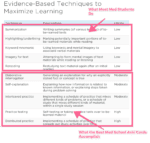

Various medical science decks, often made by multiple users in collaboration, are also available. Available decks range from foreign-language decks (often constructed with frequency tables) to geography, physics, biology, chemistry and more.
#MED SCHOOL ANKI SETTINGS MANUAL#
While Anki's user manual encourages the creation of one's own decks for most material, there is still a large and active database of shared decks that users can download and use. They provide support for speech synthesis, enhanced user statistics, image occlusion, incremental reading, more efficient editing and creation of cards through batch editing, modifying the GUI, simplifying import of flashcards from other digital sources, adding an element of gamification, etc. More than 750 add-ons for Anki are available, often written by third-party developers.

Since version 0.9.9.8.2, these features are in separate plug-ins.


Japanese and Chinese reading generation Īnki can automatically fill in the reading of Japanese and Chinese text. There also is a third-party open-source ( AGPLv3) AnkiWeb alternative, called ankisyncd, which users can run on their own local computers or servers. This allows users to keep decks synchronized across multiple computers and to study online or on a cell phone.
#MED SCHOOL ANKI SETTINGS FREE#
One card may have a question (expression) and an answer (pronunciation, meaning).īy keeping the separate cards linked to the same fact, spelling mistakes can be adjusted against all cards at the same time, and Anki can ensure that related cards are not shown in too short a spacing.Ī special note type allows generation of cloze deletion cards (in Anki 1.2.x, those were ordinary cards with cloze markup added using a tool in the fact editor).Īnki supports synchronization with a free (but proprietary) online service called AnkiWeb. The user can design cards that test the information contained in each note. This example illustrates what some programs call a three-sided flashcard, but Anki's model is more general and allows any number of fields to be combined in various cards. Field 3: Meaning of expression in familiar language – "cake".Field 1: Expression in target language – "gâteau".For example, with respect to learning a language, a note may have the following fields and example entries: Notes are analogous to database entries and can have an arbitrary number of fields. The decks of cards, along with the user's statistics, are stored in the open SQLite format.Ĭards are generated from information stored as "notes". The cards are presented using HTML and may include text, images, sounds, videos, and LaTeX equations. Anki's implementation of the algorithm has been modified to allow priorities on cards and to show flashcards in order of their urgency. The SM-2 algorithm, created for SuperMemo in the late 1980s, forms the basis of the spaced repetition methods employed in the program. The name comes from the Japanese word for "memorization" ( 暗記). Anki ( /ˈɒŋkiː/ Japanese: ) is a free and open-source flashcard program using spaced repetition, a technique from cognitive science for memorization.


 0 kommentar(er)
0 kommentar(er)
